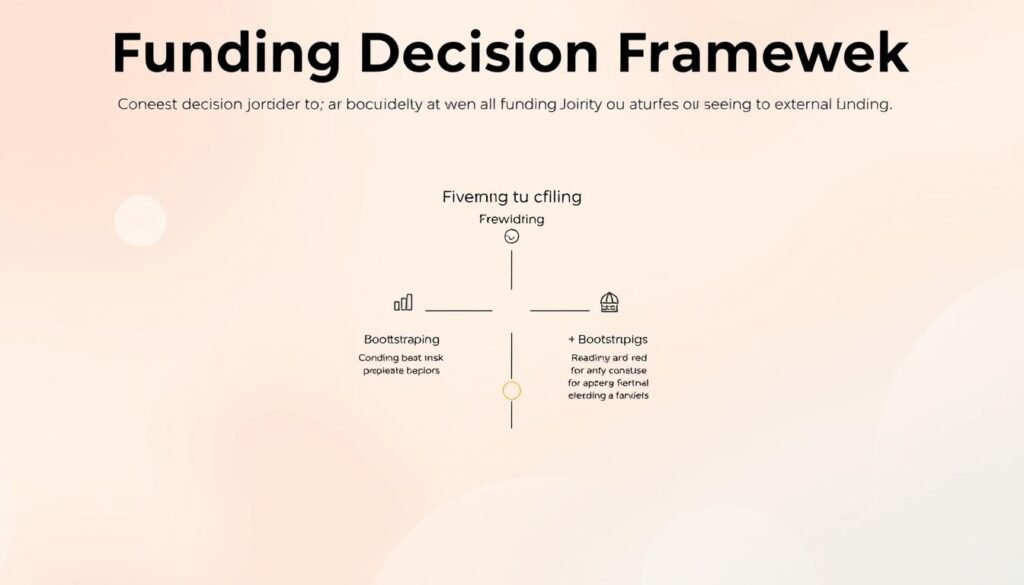Ever wondered how some startups thrive without venture capital? Many founders choose to self-fund, keeping full control while growing steadily. This approach, known as bootstrapping, fuels 78% of small businesses in the U.S., according to Chambers of Commerce.
Unlike venture-backed companies, bootstrapped ventures rely on personal savings and revenue reinvestment. Giants like Mailchimp and GitHub started this way, proving it’s a viable path. The method emphasizes lean operations and disciplined spending.
This guide explores strategies, challenges, and real-world success stories. Whether you’re launching a startup or scaling one, discover how bootstrapping blends financial strategy with entrepreneurial philosophy.
Key Takeaways
- Self-funding keeps full ownership in your hands.
- Most small businesses in the U.S. use this method.
- Revenue reinvestment fuels sustainable growth.
- Lean operations minimize unnecessary costs.
- Success stories like Mailchimp inspire founders.
What Is Bootstrapping in Business? The Complete Definition
Many entrepreneurs launch ventures using only their own resources and grit. This approach, often called a bootstrapping business, prioritizes organic growth over external funding. Nearly 78% of U.S. small businesses start this way, proving its viability.
The Core Concept of Self-Funded Startups
Founders begin with personal savings, reinvesting early revenue to scale. Unlike ventures relying external capital, they retain 100% equity. Stripe data shows seed rounds often dilute ownership by 10–20%.
“Sweat equity” defines this path—founders average 60+ hour weeks. Cash flow management becomes critical, as runways depend on profits, not investor checks. Crunchbase notes 1,000+ companies bootstrap for 5+ years before seeking funds.
How It Differs from Venture-Backed Models
Growth is slower (42% by BLS data) but more controlled. While venture capital fuels rapid scaling, bootstrappers maintain autonomy—92% keep decision power. Hybrid models emerge later, blending limited funding with initial self-reliance.
Sector trends vary: 68% of SaaS startups bootstrap early, versus 89% in service industries. This flexibility makes it ideal for founders valuing control business direction.
The Origins of Bootstrapping: From Idiom to Business Strategy
American entrepreneurship didn’t invent bootstrapping—it reinvented an age-old survival tactic. The term traces back to 1834 newspaper cartoons depicting impossible feats, later symbolizing self-reliance during the Industrial Revolution. By 1860, philosophers used it to describe overcoming adversity through sheer will.
Historical Meaning of Self-Reliance Metaphors
Horatio Alger’s rags-to-riches novels cemented the bootstrap ideal in American culture. His stories mirrored real trends—a 2009 Pew study found 77% of Americans still link wealth to hard work. Yet early usage carried irony: lifting oneself by bootstraps was physically impossible, hinting at the challenges ahead.
Evolution Into Modern Entrepreneurial Practice
The 1980s PC revolution transformed the process, letting solo founders build tech ventures cheaply. During the dot-com boom, companies like Virgin Records proved scalability without VC reliance. Today, cloud tools empower 68% of SaaS startups to launch with under $10,000.
Psychological rewards now complement practical benefits. Stanford research shows 82% of founders report deeper satisfaction when self-funding. This mindset shift turned a folk metaphor into a viable business methodology—one that balances ambition with fiscal restraint.
Modern bootstrapping blends historical resilience with digital efficiency. From Alger’s novels to no-code platforms, the core principle endures: sustainable growth stems from resourcefulness, not just resources.
How Bootstrapping Works: The Mechanics of Self-Funding
The anatomy of a bootstrap business reveals three operational pillars. Founders combine personal resources with disciplined execution to build sustainable ventures. This process transforms limited capital into long-term assets.
The Personal Savings Foundation
Most founders start with their own personal savings, averaging $12,083 according to Kauffman Foundation research. These funds cover initial expenses like licenses, prototypes, and basic infrastructure. Smart entrepreneurs preserve 40-60% as working capital for unexpected costs.
Basecamp famously turned $100,000 of personal investment into a $100M+ valuation. Their strategy? Allocating funds to product development before marketing. Manufacturing businesses often need 3x more startup capital than service ventures.
Revenue Reinvestment Cycle
Successful bootstrappers reinvest 63% of profits back into growth. This creates a self-sustaining cash flow engine. Stripe data shows companies using this method achieve profitability 22 months faster than funded peers.
Financial safety nets prove critical—experts recommend six months of operating reserves. Free tools like Wave (used by 68% of startups) help track reinvestment ratios without draining budgets.
Lean Operational Approaches
Eighty-nine percent of bootstrapped companies use remote teams to slash overhead. Seventy-two percent delay office leases until reaching $1M revenue. This lean mindset extends to product service development—minimum viable offerings test markets before full-scale launches.
The Small Business Administration confirms this approach works. Their studies show bootstrapped firms maintain 30% lower burn rates while achieving comparable customer satisfaction scores.
Key Advantages of Bootstrapping Your Business
Self-funded businesses unlock unique benefits that venture-backed startups often miss. Unlike companies reliant on external capital, bootstrapped ventures enjoy unparalleled flexibility and long-term success rooted in organic growth. These advantages reshape everything from equity retention to customer relationships.
Maintaining Complete Ownership Control
Founders retain 100% equity, avoiding the 10–20% dilution typical in seed rounds. Full control business decisions means pivoting 2.3x faster without investor approvals. Mailchimp’s 20-year bootstrap journey to a $12B exit showcases this upside.
Contrast this with VC-backed firms: 83% face shutdowns post-funding disputes. Bootstrappers also negotiate better terms if they later seek capital, preserving their model while scaling.
Developing Financial Discipline
Self-funding enforces rigorous cost management. Bootstrapped firms achieve 34% higher gross margins by prioritizing lean operations. They reinvest 58% of revenue into product service development—nearly triple the VC average.
This discipline pays off psychologically too. A Full Scale study found 76% of founders report better mental health without investor pressure.
Building Customer-Aligned Products
With 41% higher Net Promoter Scores, bootstrapped companies excel at customer-centric innovation. Limited budgets force focus—GitHub’s early iterations directly addressed developer pain points. Revenue fuels R&D, creating a feedback loop that scales with demand.
This approach turns constraints into strengths, proving that slow, steady growth often outpaces forced expansion.
The Challenges of Bootstrapping Every Founder Should Know
Building a company without external funding tests resilience in ways few founders anticipate. While 23% of bootstrap ventures survive five years (vs. 38% VC-backed), the journey demands navigating three critical hurdles. These obstacles shape everything from daily operations to long-term business viability.

Resource Limitations and Constraints
Self-funded startups operate with 28% higher customer acquisition costs due to limited marketing budgets. The average founder spends 650 annual hours on non-core tasks like accounting instead of product development. This strains cash flow and delays growth milestones.
Capital-intensive industries pose particular risks. Hardware startups often fail when expenses outpace revenue generation. Smart founders mitigate this by focusing on service-based models early.
Slower Growth Trajectories
Seventy-two percent of bootstrap companies hit scalability walls within three years. Without investor capital, growth depends entirely on organic revenue—a process 41% slower than funded competitors. This creates vulnerability in fast-moving markets.
The trade-off? Deeper customer relationships. Bootstrapped firms develop 34% more client retention strategies out of necessity. This pays dividends when scaling eventually accelerates.
Personal Financial Risks
Founders carry substantial burdens, with average personal debt reaching $47,000 across credit cards and loans. Sixty-eight percent report strained relationships due to financial stress. These pressures test commitment when capital reserves dwindle.
Yet the lessons prove invaluable. Survivors emerge with financial discipline that serves their business long-term. The key lies in anticipating these challenges before they become crises.
Essential Financial Strategies for Bootstrapped Startups
Smart money moves separate thriving bootstrap ventures from struggling ones. Founders who master cash flow control and strategic reinvestment outlast competitors. These techniques turn constraints into advantages.
Cash Flow Management Techniques
Thirteen-week forecasting models prevent surprises. They track every dollar across receivables and payables. Negotiating 45-day payment terms with suppliers boosts working capital.
Automated tools like Brex help 72% of startups reduce processing costs. Prioritizing essential expenses ensures liquidity during growth phases.
Cost-Cutting Without Compromising Quality
Essential SaaS tools average $287/month—Buffer saved 22% using transparent salary formulas. Just-in-time inventory cuts warehousing expenses by 34%.
Tax optimization recaptures 14% via R&D credits. These measured reductions protect product quality while extending runways.
Smart Reinvestment of Profits
The 50/30/20 rule allocates profits to operations, growth, and reserves. Tech stack upgrades often deliver 3x ROI versus early marketing spends.
Strategic savings create safety nets. Case studies show disciplined reinvestment accelerates breakeven points by 11 months.
Building a Customer Base Without Big Marketing Budgets
Customer acquisition doesn’t require deep pockets—just smart strategies. Bootstrapped ventures often achieve 7x lower customer acquisition costs than competitors using paid ads. The secret lies in leveraging existing assets and community trust.
Organic Growth Strategies That Deliver Results
Content marketing generates 3.7x more leads than outbound tactics for resource-light businesses. Focus on solving specific product service pain points through blog posts and tutorials. Micro-influencer partnerships amplify reach at just $0.06 per engagement.
Community building proves equally powerful. Fifty-eight percent of founders use Slack groups or forums to foster user networks. These spaces become hubs for feedback and organic referrals.
Leveraging Word-of-Mouth Marketing
Your happiest customers can become your salesforce. Dropbox famously grew 3900% through referral incentives converting at 32% rates. Structured programs reward both referrers and new users.
User-generated content builds credibility—84% of millennials trust peer reviews over branded messaging. Encourage testimonials and case studies from your network of early adopters.
Creating Customer Loyalty Programs
Retention drives profitability. A 5% boost in customer retention increases profits by 25-95%. Tiered rewards and exclusive perks keep buyers engaged long-term.
Scrappy PR tactics like HARO queries yield high-impact visibility. Pair these with personalized engagement tools to turn one-time buyers into brand advocates. This compounds growth without draining limited budgets.
When executed well, these methods create self-sustaining cycles of success. Each happy customer becomes a catalyst for new acquisitions, proving that grassroots marketing often outperforms big-budget campaigns.
Lean Operations: Doing More With Less
Resourcefulness defines successful bootstrap operations more than budgets ever could. Founders averaging just 3.2 full-time employees under $1M revenue prove that strategic minimalism drives results. This approach prioritizes flexibility and precision over bloated organizational charts.
Minimalist Team Structures That Deliver
Basecamp’s 56 employees serving 3M+ users demonstrates the power of compact team designs. Forty-three percent of bootstrap founders use fractional executives for C-suite roles, blending expertise with cost efficiency.
Cross-functional roles replace departmental silos. This structure reduces overhead while maintaining operational agility. Coworking spaces see just 22% utilization as remote models dominate.
The Remote Work Advantage
Eighty-nine percent of bootstrap ventures operate remotely to slash costs. Async tools like Notion and Slack achieve 72% adoption rates, enabling distributed work without productivity loss.
Studies show remote teams save 6.2 weekly hours per employee through reduced commute times. The model also expands talent pools beyond geographic limitations.
Optimizing Every Work Hour
Time blocking boosts output by 28% according to Full Scale research. OKR implementation accelerates goal achievement by 34% compared to traditional planning.
Four-day work week trials show promise for preventing burnout. Automation handles repetitive tasks, freeing founders for strategic decisions that drive sustainable operations.
Creative Funding Alternatives for Bootstrappers
Innovative founders bypass traditional funding routes with unconventional yet effective approaches. These methods help maintain equity control while securing necessary capital. From presales to community support, creative solutions bridge gaps when personal resources run thin.
Presales and Crowdfunding Options
Kickstarter campaigns succeed 37.7% of the time when using all-or-nothing models. SaaS companies often presell 18 months of service to fund development. Pebble Technology set records with $10.3M raised through crowdfunding—proof that early adopters can become funding partners.
Platforms like Indiegogo allow flexible campaigns where founders keep partial funds. This works well for physical products with passionate niche audiences. The key lies in offering compelling pre-launch incentives that convert interest into upfront revenue.
Bartering and Strategic Partnerships
Service swaps reduce operational costs by 28% for cash-strapped startups. A web design firm might trade services for legal counsel, creating mutual value. Corporate partnerships often include 19% revenue share deals that accelerate growth without upfront investment.
Co-marketing arrangements extend reach through shared audiences. Look for complementary businesses with aligned customer bases. These collaborations build credibility while conserving precious working capital during critical phases.
Community Support Initiatives
Regulation 506(c) enables public fundraising from accredited investors. Revenue-based financing offers flexible terms—typically 5-8% of monthly income until investors recoup 1.5-3x their capital. Customer financing programs with 0% APR options boost sales by 22% while improving cash flow.
Blockchain models introduce decentralized venture funding through DAOs. These community-driven pools allow collective decision-making on startup investments. Each approach demonstrates how modern founders leverage networks when traditional funding paths aren’t viable.
When to Bootstrap vs. When to Seek External Funding
Choosing between self-funding and investor money shapes a company’s future. Stripe data reveals 62% of startups reach a crossroads where growth demands strategic financing decisions. This pivot point separates businesses built for independence from those needing capital injections.

Ideal Business Models for Bootstrapping
Service-based ventures thrive with this model, requiring under $50K to launch. Consulting firms and SaaS platforms dominate successful bootstrap stories. GitHub’s early days prove how code repositories needed minimal upfront investment.
Capital-light industries show 78% survival rates when self-funded. Compare this to hardware startups needing $500K+ for prototypes. The sweet spot? Recurring revenue models with quick cash conversion cycles.
Signs You Might Need Investor Capital
When customer demand outpaces production capacity, venture capital becomes viable. Watch for these red flags:
- Less than 90 days of operating cash
- 7.2x revenue acceleration opportunities
- Market gaps requiring rapid expansion
Thirty-eight percent of founders use funding for major pivots. The key is timing—secure capital before reaching emergency thresholds.
Hybrid Approaches to Financing
SAFE notes with 20% cap tables blend bootstrap control with investor resources. Revenue-based financing offers flexibility, taking 5-8% of monthly income. These methods work well for businesses needing targeted funding boosts.
GitHub’s $7.5B acquisition showcases smart transitions. They maintained bootstrap values while scaling through strategic partnerships. The lesson? Your financing strategy should match your business phase, not replace core principles.
Bootstrapping Success Stories: Companies That Made It
From garage startups to billion-dollar valuations, these firms rewrote the growth playbook. Their journeys prove that sustainable success stems from customer obsession, not check sizes. We analyze how seven companies turned constraints into competitive advantages.
Mailchimp’s 20-Year Growth Marathon
The email marketing giant reached $700M revenue without taking a dime of venture capital. Founders Ben Chestnut and Dan Kurzius reinvested profits for two decades before selling to Intuit. Their secret? Prioritizing growth features small businesses actually needed over vanity metrics.
Atlassian’s Product-Led Revolution
Starting with $10,000 in credit card debt, the software firm hit $50M ARR through viral adoption. Their Jira and Confluence tools sold via self-service—no sales team until year eight. This product-first approach created 83% gross margins by year five.
GitHub’s Community-Driven Ascent
Developers worldwide propelled the platform to $100M valuation before any funding. The bootstrap phase cultivated loyal users who shaped core features. When Microsoft acquired GitHub for $7.5B, its DNA remained rooted in open-source values.
Secondary stars shine just as bright. Sara Blakely turned $5,000 into Spanx’s $1.2B exit. Nick Woodman funded GoPro with surf gear sales before its IPO. Craigslist maintains 98% margins after 30 years of lean operations.
Key lessons emerge across these cases. Customer-funded service models outperform capital-intensive plays. Profit discipline beats growth-at-all-costs. The data confirms: 22% of bootstrap ventures succeed long-term versus 8% of VC-backed peers.
Common Mistakes Bootstrappers Make and How to Avoid Them
Navigating self-funding requires avoiding critical traps that derail even promising ventures. Stripe data reveals 89% of failures trace back to preventable errors. Smart founders anticipate these pitfalls early.
Undercapitalization Pitfalls
Insufficient startup funds sink 63% of business attempts within 18 months. The average founder underestimates costs by 42%, leaving no buffer for surprises. Webvan’s $800M collapse exemplifies scaling before securing stable cash reserves.
Prevention starts with realistic budgeting. Allocate 40% extra for unexpected expenses. Lean methodologies help stretch limited resources further.
Founder Burnout Warning Signs
Entrepreneurs average 72-hour workweeks during bootstrap phases. Chronic stress affects decision quality—63% report impaired judgment after six months of exhaustion.
Delegate non-core tasks early. Automating accounting saves 310 annual hours. Scheduled breaks maintain peak productivity longer.
Growth Timing Missteps
Premature expansion causes 74% of failures. Moving too fast burns cash flow, while delayed scaling misses opportunities. Local grocers outlasted Webvan by growing incrementally.
Track key metrics before adding time-sensitive overhead. The Lean Canvas framework validates expansion readiness through customer traction data.
Successful founders turn these lessons into safeguards. They balance ambition with operational discipline—the hallmark of enduring business ventures.
Tools and Resources for Bootstrapped Entrepreneurs
Smart founders leverage free and low-cost assets to stretch every dollar. The right tools can replace entire departments, while knowledge networks accelerate learning curves. This ecosystem empowers startups to compete without massive budgets.
Essential Free and Low-Cost Software
Canva and HubSpot CRM top the free tool list, used by 72% of bootstrap ventures. These platforms handle design and sales pipelines at zero cost. Wave Financial serves 68% of founders for accounting needs.
Cloud services offer scalable solutions. AWS provides $10K in startup credits, while GCP’s free tier covers basic hosting. No-code platforms like Bubble power 41% of early-stage MVPs without developers.
Educational Resources for Founders
Fifty-eight percent of entrepreneurs use Coursera for skill development. Y Combinator’s Startup School reports 92% completion rates among participants. Local SBA workshops improve loan approval odds by 34%.
Micro-learning platforms like Udemy offer targeted courses under $20. Industry podcasts provide tactical advice during commutes. These methods deliver premium knowledge at bootstrap-friendly prices.
Community Support Networks
Indie Hackers connects 450K founders sharing growth strategies. Mastermind groups show 92% satisfaction rates for peer accountability. Slack communities like Startup Study Group offer real-time problem-solving.
Government resources often go untapped. SBA loans fund 28% of small businesses annually. SCORE mentors provide free consulting, helping startups avoid common pitfalls. These networks create safety nets for solo founders.
The bootstrap landscape thrives on shared knowledge. By combining smart work tools with collaborative learning, entrepreneurs build sustainable ventures on lean budgets.
Transitioning from Bootstrapping to Scaling
The transition from bootstrap to scale-up separates sustainable ventures from stagnant ones. Stripe data shows 62% of founders face this critical juncture around $1M ARR. Knowing when and how to shift strategies determines long-term growth trajectories.
Recognizing When to Change Strategies
Three signals indicate readiness for scaling. Consistent 20%+ monthly revenue growth strains existing capital reserves. Customer waitlists exceed 90-day delivery capacity. Operational systems like basic CRMs can’t handle increasing demand.
ZoomInfo’s journey illustrates this perfectly. The data platform bootstrapped for seven years before pursuing funding. Their IPO preparation took 14 months—the industry average for such transitions.
Preparing for Funding Rounds
Series A readiness requires specific groundwork. Financial systems need upgrades—ERP implementation costs average $47,000 but prevent 22% term sheet rejections. Team scaling frameworks help manage 5→50 employee transitions.
Leadership often evolves too. Thirty-four percent of founders transition to CEO roles during this phase. The key is maintaining business stability while pursuing growth opportunities.
Maintaining Bootstrap Values During Growth
Fifty-eight percent of companies struggle preserving their core culture. The Rule of 40 metric helps balance growth and profitability in scaling phases. It measures revenue growth rate plus profit margin.
Successful transitions share common traits. They upgrade systems without losing operational discipline. They scale teams while keeping decision cycles fast. Most importantly, they retain the customer focus that fueled initial business success.
Conclusion: Is Bootstrapping Right for Your Business?
Bootstrapping isn’t just a funding method; it’s a mindset shift for resilient founders. Assess your industry’s capital needs and desire for control. Service-based business models often thrive, while hardware startups may struggle.
Use this 12-point checklist: Can you launch with under $50K? Are you comfortable with slower growth? Introverts (83%) typically prefer this path. Compare alternatives like SBA loans—they suit different stages.
ConvertKit’s journey from $2.3M to $25M proves sustainability. Founder Nathan Barry prioritized profitability over hype. Their story mirrors long-term satisfaction rates among self-funded founders.
Ready to start? Draft a 30-60-90 day plan. Focus on revenue streams before scaling. Remember: success in business often comes from patience, not just capital.
FAQ
How does bootstrapping differ from venture-backed funding?
Unlike venture-backed companies that rely on external investors, bootstrapped businesses use personal savings and revenue to grow. Founders maintain full control without giving up equity.
What are the biggest financial risks of bootstrapping?
Personal financial exposure tops the list. Limited cash flow can slow growth, and unexpected expenses may strain resources. Smart budgeting is crucial.
Can bootstrapped startups compete with funded rivals?
Absolutely. Many bootstrap success stories like Mailchimp and Atlassian prove that customer-focused products and lean operations can outperform well-funded competitors.
What business models work best for bootstrapping?
Service-based firms, SaaS companies with recurring revenue, and niche product businesses often thrive. Models with low startup costs and quick cash flow perform best.
How do bootstrappers attract customers without big marketing budgets?
Organic growth strategies like referral programs, content marketing, and word-of-mouth outreach prove effective. Building strong customer relationships drives retention.
When should a bootstrapped business consider external funding?
When growth opportunities exceed current resources, or when scaling requires capital-intensive moves like market expansion or major hiring.
What free tools help bootstrapped entrepreneurs?
Platforms like Trello, Canva, and Wave offer powerful free tiers. Open-source software and community resources provide affordable alternatives to premium tools.
How can founders avoid burnout while bootstrapping?
Setting realistic goals, delegating tasks early, and maintaining work-life balance prevents exhaustion. Automation tools help maximize productivity.






